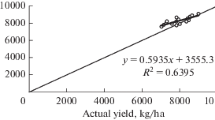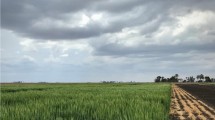Abstract
This study set out to (1) calibrate and evaluate the performance of APSIM in simulating maize response to N, P and residue management and (2) identify strategies to reduce instability in crop production, and increase the efficiency of mineral fertilizer use. The response of maize to inorganic nitrogen (N) and phosphorus (P) additions were determined in the coastal savannah agro-ecology in the main rainy and secondary rainy seasons, of 2008 and 2009. Field experiments were set-up in a randomized complete block design with different levels of N (0–120 kg N ha−1) and P (0–30 kg P2O5 ha−1) mineral fertilizer. The APSIM model adequately simulated agroecosystem dynamics, resulting in the following RMSE values: anthesis (1.2 days), maturity (2.0 days), maximum LAI (0.18 m2m−2) total-biomass (543 kg ha−1), grain yield (318 kg ha−1), N uptake (12.6 kg ha−1), P uptake (2.2 kg ha−1) and in-season soil water content (0.01 mm). A long-term simulation study (30 years) showed that probabilities of obtaining higher yields were higher in the main growing season than in the secondary growing season. The efficiency of mineral N fertilizer use was also higher in the main growing season. The use of 40 kg N ha−1 mineral N fertilizer in both seasons was more efficient than using 80 kg N ha−1. The variability in the efficiency of mineral fertilizer use was higher in the secondary growing (44–96 %) than in the main growing season (27–48 %). Retaining crop residues yielded higher stability in grain production and increased the minimum grain yield production significantly. Applying 40 kg N ha−1 and 30 kg P2O5 ha−1 mineral fertilizer with crop residue retention will reduce the uncertainty in maize production, particularly in the secondary growing seasons which are characterized by prolonged drought spells. This study suggests that resource-poor farmers will be better off prioritizing the main growing season for rainfed maize production and applying a moderate amount (40 kg N ha−1) of N fertilizer rather than the 90 kg N ha−1 currently recommended for the coastal savannah of Ghana in the secondary growing season because of the higher instability in yields associated with N fertilizer use in this season.












Similar content being viewed by others
References
Adiku SGK, Jones JW, Kumaga FK, Tonyigah A (2009) Effects of crop rotation and fallow residue management on maize growth, yield and soil carbon in a forest–savanna transition zone of Ghana. J Agric Sci 147:313–322
Akponikpe PBI, Gérard B, Michels K, Bielders C (2010) Use of the APSIM model in long term simulation to support decision making regarding nitrogen management for pearl millet in the Sahel. Eur J Agron 32:144–154
Akponikpè PBI, Minet J, Gérard B, Defourny P, Bielders CL (2011) Spatial fields’ dispersion as a farmer strategy to reduce agro-climatic risk at the household level in pearl millet-based systems in the Sahel: a modeling perspective. Agric For Meteorol 151:215–227
Bationo A, Mokwunye U, Vlek PLG, Koala S, Shapiro BI (2003) Soil fertility management for sustainable land use in West Africa. In: Gichuru MP, Bationo A, Bekunda MA, Goma HC, Mafongonya PL, Mugendi DN, Murwira HM, Nandwa SM, Nyathi P, Swift MJ (eds) Soil fertility management in Africa: a regional perspective. Academy of Science Publishers, Kenya
Braimoh AK, Vlek PLG (2006) Soil quality and other factors influencing maize yield in northern Ghana. Soil Use Manag 22:165–171
Dalgliesh N, Hochman Z, Huth N, Holzworth D (2012) A protocol for the development of soil parameter values for use in APSIM. CSIRO Ecosystem Science, Toowoomba
Debre S, Abbeney-Mickson S, Sabi EB, Yangyurou M (2011) Use of the SPAW model to simulate the water balance components of the ARC-Kpong irrigation tank. J Ghana Inst Eng 8:39–46
Dzotsi KA, Jones JW, Adiku SGK, Naab JB, Singh U, Porter CH, Gijsman AJ (2010) Modeling soil and plant phosphorus within DSSAT. Ecol Model 221:2839–2849
Fonte SJ, Yeboah E, Ofori P, Quansah GW, Vanlauwe B, Six J (2009) Fertilizer and residue quality effects on organic matter stabilization in soil aggregates. Soil Sci Soc Am J 73:961–966
Fosu-Mensah BY, MacCarthy DS, Vlek PLG, Safo EY (2012) Simulating impact of seasonal climatic variation on the response of maize (Zea mays L.) to inorganic fertilizer in sub-humid Ghana. Nutr Cycl Agroecosyst 94:255–271
HarvestChoice (2010) Rainfall variability and crop yield potential. International Food Policy Research Institute, Washington, DC; University of Minnesota, St. Paul, MN. http://harvestchoice.org/node/2240
Henao J, Baanante CA (1999) Estimating rates of nutrient depletion in soils of agricultural lands of Africa. International Fertilizer Development Center, Muscle Shoals
Keating BA, Carberry PS, Hammer GL, Probert ME, Robertson MJ, Holzworth D, Huth NI, Hargreaves JNG, Meinke H, Hochman Z, Mclean G, Verburg K, Snow V, Dimes JP, Silburn M, Wang E, Brown S, Bristow KL, Asseng S, Chapman S, Mccown RL, Freebairn DM, Smith CJ (2003) An overview of APSIM, a model designed for farming systems simulation. Eur J Agron 18:267–288
Kibunja CN, Mwaura FB, Mugendi DN, Wamae DK, Bationo A (2011) Long term land management effects on crop yields and soil properties in the sub-humid highlands of Kenya. In: Bationo A, Waswa B, Okeyo JM, Maina F, Kihara J (eds) Innovations as key to Green Revolution in Africa. Springer, Berlin, pp 169–174
Kumar K, Goh KM (1999) Crop residues and management practices: effects on soil quality, soil nitrogen dynamics, crop yield, and nitrogen recovery. Adv Agron 68:197–319
Laux P, Kunstmann H, Bardossy A (2008) Predicting the regional onset of the rainy season in West Africa. Int J Climatol 28:329–342
Legates DR, McCabe GJ (1999) Evaluating the use of ‘goodness-of-fit’ measures in hydrologic and hydro-climatic model validation. Water Resour Res 35:233–241
MacCarthy DS, Vlek PLG (2012) Impact of climate change on sorghum production under different nutrient and crop residue management in semi-arid region of Ghana: a modeling perspective. Afr Crop Sci J 20(2):275–291
MacCarthy DS, Sommer R, Vlek PLG (2009) Modeling the impacts of contrasting nutrient and residue management practices on grain yield of sorghum (Sorghum bicolor (L.) Moench) in a semi-arid region of Ghana using APSIM. Field Crops Res 113(2):105–115
MacCarthy DS, Vlek PLG, Fosu-Mensah BY (2012) The response of maize to N fertilization in a sub-humid region of Ghana; understanding the processes using a crop simulation model. In: Kihara J, Hoogenboom G, Bationo A (eds) Improving soil fertility recommendation in Africa using Decision Support for Agro-technological Transfers (DS SAT). Springer. doi:10.1007/978-94-007-2960-5-5
Nyalemegbe KK, Darkwa EO, Yangyuoru M, Mawunya FD, Acquah DK, Oteng JW, Terry PJ, Willcocks TJ (2009) The effect of camber-bed drainage landforms on soil nutrient distribution and grain yield of maize on the Vertisols of the Accra plains of Ghana. West Afr J Appl Ecol 16:1–8
Owusu-Bennoah E, Acquaye DK (1989) Phosphate sorption characteristics of selected major Ghanaian soils. Soil Sci 148:114–123
Paul BK, Vanlauwe B, Ayuke F, Gassner A, Hoogmoed M, Hurisso TT, Koala S, Lelei D, Ndabamenye T, Six J, Pulleman MM (2013) Medium-term impact of tillage and residue management on soil aggregate stability, soil carbon and crop productivity. Agric Ecosyst Environ 164:14–22
Sanchez PA, Shepherd KA, Soule MJ, Place FM, Buresh RJ, Izac A-MN, Mokwunye AU, Kwesiga FR, Ndiritu CG, Woomer PL (1997) Soil fertility replenishment in Africa: an investment in natural resource capital. In: Buresh RJ, Sanchez PA, Calhon F (eds) Replenishing soil fertility in Africa. SSSA special publication no. 51. Soil Science Society of America and American Society Agronomy, Madison, pp 1–46
Saxton KE, Rawls WJ (2006) Soil water characteristic estimates by texture and organic matter for hydrologic solutions. Soil Sci Soc Am J 70:1569–1578
Singh U (1985) A crop growth model for predicting corn (Zea mays L.) performance in the tropics. PhD thesis, University of Hawaii, Honolulu
Soler CMT, Bado VB, Traore K, Bostick WM, Jones JW, Hoogenboom G (2011) Soil organic carbon dynamics and crop yield for different crop rotations in a degraded ferruginous tropical soil in a semi-arid region: a simulation approach. J Agric Sci 149:579–593
Stoorvogel J, Smaling EMA (1990) Assessment of soil nutrient depletion in sub-Saharan Africa. Winand Staring Centre, Wageningen
Wallach D, Makowski D, Jones JW (eds) (2006) Working with dynamic crop models: evaluation, analysis, parameterization, and applications. Elsevier, Amsterdam
Wilson DR, Muchow RC, Murgatroyd CJ (1995) Model analysis of temperature and solar radiation limitations to maize potential productivity in a cool climate. Field Crops Res 43:1–18
Wopereis MCS, Tamelokpo A, Ezui K, Gnakpenou D, Fofana B, Breman H (2006) Mineral fertilizer management of maize on farmer fields differing in organic inputs in the West African Savanna. Field Crop Res 96(2–3):355–362
Yangyuoru M, Adiku SGK, Laryea KB (2012) Changes in shape and water shedding potential of three landforms on the vertisol in Ghana. J Ghana Sci Assoc 14(1):10
Zougmore R, Mando A, Stroosnijder L (2010) Benefits of integrated soil fertility and water management in semi-arid West Africa: an example study in Burkina Faso. Nutr Cycl Agroecosyst 88:17–27
Author information
Authors and Affiliations
Corresponding author
Rights and permissions
About this article
Cite this article
MacCarthy, D.S., Akponikpe, P.B.I., Narh, S. et al. Modeling the effect of seasonal climate variability on the efficiency of mineral fertilization on maize in the coastal savannah of Ghana. Nutr Cycl Agroecosyst 102, 45–64 (2015). https://doi.org/10.1007/s10705-015-9701-x
Received:
Accepted:
Published:
Issue Date:
DOI: https://doi.org/10.1007/s10705-015-9701-x




